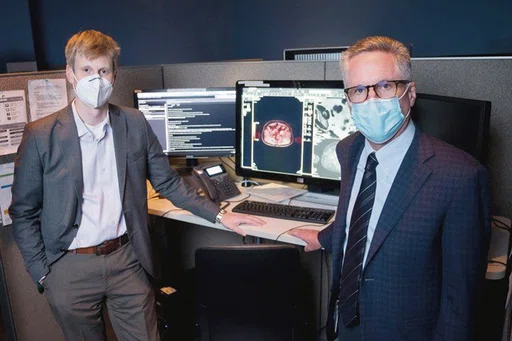result
5. US FDA. Press release, December 1, 2020. Available at: https://www.fda.gov/news-events/press-announcements/fda-
approves-first-psma-targeted-pet-imaging-drug-men-prostate-cancer#:~:text=Today%2C%20the%20U.S.%20Food%20
and,in%20men%20with%20prostate%20cancer.


PREVIOUS
${prev-page}
NEXT
${next-page}
Subscribe Now
Manage Subscription
FOLLOW US
Contact Us • Cookie Preferences • Privacy Policy • California Privacy PolicyDo Not Sell or Share My Personal Information • Terms & Conditions • Security
© 2024 GE HealthCare. GE is a trademark of General Electric Company. Used under trademark license.
NEWS
FDA approves first PSMA-targeted PET imaging radiotracer for men with prostate cancer
FDA approves first PSMA-targeted PET imaging radiotracer for men with prostate cancer

Thomas Hope, MD, (left) and Peter Carroll, MD, (right) chair of the Urology Department at UCSF, stand at the PACS workstation where the images from the PSMA PETs are viewed and interpreted.
Photo by Maurice Ramirez, courtesy of UCSF.
In December 2020, the US Food and Drug Administration approved Gallium 68 PSMA-11 (68Ga PSMA-11), the first radiotracer for positron emission tomography (PET) imaging of prostate-specific membrane antigen (PSMA) positive lesions in men with prostate cancer5. Known as PSMA PET, the technique is highly effective in detecting prostate cancer throughout the body so that it can be better and more selectively treated. It may help identify cancer that could be missed by current standard-of-care imaging techniques. Providers now have a new imaging approach to assess if the cancer has spread to other parts of the body. The PSMA tracer can be used with either PET/MR or PET/CT scans.
The US FDA granted approval to the University of California, Los Angeles, and the University of California, San Francisco (UCSF). In a statement released by UCSF, Thomas Hope, MD, an associate professor at UCSF, said, “It is rare for academic institutions to obtain FDA approval of a drug, and this unique collaboration has led to what is one of the first co-approvals of a drug at two institutions. We hope that this first step will lead to a more widespread availability of this imaging test to men with prostate cancer throughout the country.”








